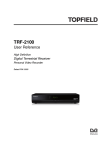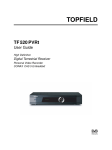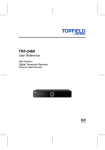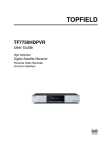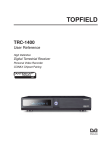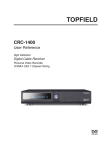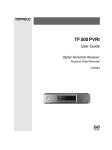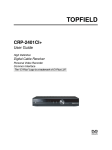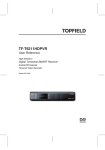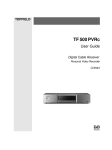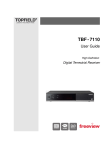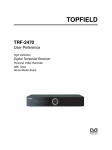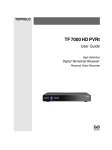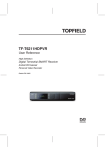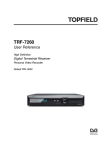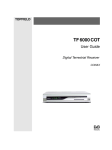Download user manual for the TBF-200HD
Transcript
TBF-200HD User Manual High Digital Terrestrial Receiver USB PVR-Ready Default PIN: 2010 ii The lightning flash with arrowhead symbol, in an equilateral triangle, is intended to alert the user to the presence of uninsulated “dangerous voltage” within the product’s enclosure that may be of sufficient magnitude to constitute a risk of electric shock to a person. The exclamation point, in an equilateral triangle, is intended to alert the user to the presence of important operation and maintenance instructions in the literature accompanying the product. Precautions • • • • • • • • • • • • • • • Read, keep and follow these instructions. Heed all warnings. Clean with a dry cloth only. Do not block any of the ventilation openings. Do not install near any heat sources or in direct sunlight as this will impair cooling. Do not operate this product near water. Do not place any of the objects filled with liquids, such as vases on this unit. Do not try to change the plug or defeat its safety purpose. If the provided plug does not fit into your outlet, consult an electrician for replacement of the obsolete outlet. This product is designed for indoor use only. Place the digital receiver on a firm and level surface. Do not lay any objects such as magazines on this unit. Do not overload power outlets. Doing so may result in a risk of fire or electrical shock. Never open this unit’s casing under any circumstances, or the warranty will be void. Unplug this unit during lightning storms or when unused for long periods of time. Refer all servicing to qualified service personnel. Servicing is required when the unit has been damaged in any way, such as power supply cord or plug is damaged, liquid has been spilled or objects have fallen into the unit, the unit became wet from rain or moisture, does not operate normally, or has been dropped. Batteries, including those which contain no heavy metals, may not be disposed with other household wastes. Please dispose of used batteries in an environmentally sound manner. Find out the legal regulations which apply in your area. iii About this user guide Thank you for purchasing our digital receiver. Please read this user guide carefully before you use the digital receiver and keep it handy for future reference. This User Guide covers the model TBF-200HD . • Illustrations pictured in this manual may not be exactly the same as the actual product. • The screenshots used in this manual may not be exactly the same as those you see on the actual on-screen displays. • Designs and specifications of the digital receiver and other accessories are subject to change without any notice in order to introduce new features or improve the functionality of the product. iv CONTENTS Contents Contents 1 . . . . . . . . . . . . . . . . . . . . . . . . . . . . . . . . . . . . . . . . . . . . . . . . . . . . 1 2 2 3 4 Setup 2.1 Unpacking . . . . . . . . . . . . . . . . . 2.2 Safety precautions . . . . . . . . . . . . . 2.3 Rear panel connections . . . . . . . . . . 2.4 Connecting up your digital receiver . . . 2.4.1 Connecting to the antenna . . . . 2.4.2 Connecting to your television set 2.5 Switching on for the first time . . . . . . . . . . . . . . . . . . . . . . . . . . . . . . . . . . . . . . . . . . . . . . . . . . . . . . . . . . . . . . . . . . . . . . . . . . . . . . . . . . . . . . . . . . 7 7 7 9 10 10 11 12 3 Service Search 3.1 Searching for broadcasting services . . . . . . . . . . . . . . . 3.2 Reset to factory settings . . . . . . . . . . . . . . . . . . . . . . 14 14 15 4 Preference Settings 4.1 Language settings . . . . . . . . . . . . . . . . . . . . . . . . . 4.1.1 Menu language . . . . . . . . . . . . . . . . . . . . . . 4.1.2 Audio language . . . . . . . . . . . . . . . . . . . . . . 16 16 16 17 2 Introduction 1.1 Features . . . . . . . . . . . . . 1.2 Controlling the digital receiver . 1.2.1 Front panel . . . . . . . 1.2.2 Remote control . . . . . iv . . . . . . . . . . . . . . . . CONTENTS v 4.2 . . . . . . . . . . . . . . . . . . . . . . . . . . . . . . . . . . . . . . . . . . . . . . . . . . . . . . . . . . . . . . . . . . . . . . . . . . . . . . . . . . . . . . . . . . . 17 17 18 18 19 20 22 Every Day Use 5.1 Volume control . . . . . . . . . . . . . . 5.2 Watching television . . . . . . . . . . . . 5.2.1 The services list . . . . . . . . . . 5.2.2 Viewing programme information 5.2.3 Selecting audio tracks . . . . . . 5.2.4 Selecting subtitle tracks . . . . . 5.3 Viewing electronic programme guide . . 5.4 Using time-shift . . . . . . . . . . . . . . . . . . . . . . . . . . . . . . . . . . . . . . . . . . . . . . . . . . . . . . . . . . . . . . . . . . . . . . . . . . . . . . . . . . . . . . . . . . . . . . . . . . . . . . . . . . . . . . 23 23 23 23 24 25 25 25 26 6 Organising Services 6.1 Editing the services list . . . . . . . . . . . . . . . . . . . . . . 28 28 7 Recording and Playback 7.1 Recording a programme . . . . . . . . . . . . . . . . . . . . 7.1.1 Instant recording . . . . . . . . . . . . . . . . . . . . 7.1.2 Timer recording . . . . . . . . . . . . . . . . . . . . . 7.1.3 Scheduling recordings using the programme guide . 7.2 File archive . . . . . . . . . . . . . . . . . . . . . . . . . . . . 7.2.1 To delete a recording . . . . . . . . . . . . . . . . . . 7.2.2 To lock a recording . . . . . . . . . . . . . . . . . . . 7.2.3 To rename a recording . . . . . . . . . . . . . . . . . 7.3 Playing back a recording . . . . . . . . . . . . . . . . . . . . 7.3.1 To play in slow motion . . . . . . . . . . . . . . . . . 7.3.2 To play in fast motion . . . . . . . . . . . . . . . . . . 31 31 32 33 36 36 37 37 37 38 39 39 4.3 4.4 4.5 5 Video and audio settings . . . 4.2.1 Video Resolution . . . 4.2.2 Television aspect ratio 4.2.3 Audio mode . . . . . . Local time setting . . . . . . . Parental control . . . . . . . . Options for On-Screen Display . . . . . . . . . . . . . . . . . . . . . . . . . . . . . . . . . . . . . . . . . . . . . . vi CONTENTS 7.3.3 To play back recordings in sequence . . . . . . . . . . Playing back a video . . . . . . . . . . . . . . . . . . . . . Formatting the hard disk . . . . . . . . . . . . . . . . . . . . . 39 39 40 Firmware Update 8.1 From a memory stick . . . . . . . . . . . . . . . . . . . . . . . 41 41 7.4 7.5 8 1 Chapter 1 Introduction The TBF-200HD digital receiver is fully compliant with the international Digital Video Broadcasting (DVB) standard, and thus is able to receive digital broadcasts of that standard. For its operation you need an antenna, which must be installed appropriately. For the latest news and information, join the Topfield forum at http://www.topfield.com.au. NOTE In general we equate a channel with a frequency. However, unlike analogue broadcasts, digital broadcasts are not all assigned to their own frequencies; instead, multiple television broadcasts are transmitted through a single frequency. The frequency in digital broadcasting is usually called transponder or multiplex. To reduce confusion in this manual, the word service is preferably used than channel as a term to indicate one television or radio broadcast. 2 Introduction 1.1 Features This digital receiver has the following features: • Can store up to 2,000 television and radio services. • You can edit the services list. • Can create lists of your favourite services. • Can view information about the current television or radio programme. • Has an electronic programme guide that provides an overview of scheduled programmes. • Time-shift is a special technical feature available on this digital receiver. You can pause a programme you are watching and resume it again at a later time. Then you can quickly go to any part of the current programme by fast forward or rewind search. • If you have an external hard drive connected to the digital receiver via the USB port, you can record television programmes into it. 1.2 Controlling the digital receiver You can operate the digital receiver with the remote control or the buttons on the front panel. NOTE When the digital receiver is off but plugged into a wall socket, we say that it is in standby mode; on the other hand, when it is on, it is in active mode. Even when you are not using the digital receiver, you should keep it plugged into a wall socket to be in standby mode so that it can run timer events at any time. 1.2 Controlling the digital receiver 3 1.2.1 Front panel The front panel of the digital receiver has buttons to control the digital receiver, specific lights and a display. −, + switch to previous or next service. Also navigate in menus and interactive screens. switches the digital receiver between standby/active mode. Front Display light blinks every time you press a button on the remote control. light lights up while the digital receiver is in standby mode. 4 Introduction 1.2.2 Remote control • button switches the digital receiver between standby mode and active mode. • not used in this model. • switches the remote control to television mode to operate your television. • switches the remote control to receiver mode to operate the digital receiver. • , not used in this model. • Numeric buttons are used to enter a service number for service change or to specify values for menu options. • switches over between the current service and the previously viewed one. • displays the service information box. Also, displays more information about a programme. • not used in this model. • changes aspect ratio. • switches over between television services and radio services. • changes video resolution. • not used in this model. • • displays the electronic programme guide. , buttons switch to the previous or next service. Also, navigate in menus and interactive screens displays the services list. Also, selects menu items. • • , buttons decrease or increase the volume. Also, change values for menu options. • displays the main menu. Also, returns to the previous menu from a submenu. • exits a menu or hides on-screen information. 1.2 Controlling the digital receiver 5 • V− , V+ buttons decrease or increase the volume. • mutes the sound. Press again to switch it back on. • displays the list of recorded programmes that are stored in the external hard drive. • P− , P+ buttons switch to the previous or next service. • has t functions per menu. • has t functions per menu. • has t functions per menu. • has t functions per menu. • (White Button) has multi purpose functions. • selects subtitle track. • not used in this model. • sets a sleep timer in 10 minute increments. • starts recording. • stops playback, recording, or jumps back to live television from time-shifted television. • displays connected devices list. • selects audio track, sound mode, or video track of multifeed programme. • starts reverse playback. Subsequent presses increase the rewind speed. • pauses live television or playback of a recorded programme. • resumes normal playback speed, or displays the progress bar for navigation on playback or time-shift. • starts fast forward playback. Subsequent presses increase the playback speed. • jumps back to the beginning of the recording during playback. • starts slow motion playback. Subsequent presses change the playback speed. • has • jumps to the end of the recording during playback. t functions per menu. 6 Introduction Functions of the colour buttons will be guided on the screen. NOTE When using the remote control, point it at the remote sensor on the front panel of the digital receiver. The actual images and the number of buttons may be different depending on the type of remote control provided by the manufacturer. 7 Chapter 2 Setup 2.1 Unpacking Before going any further, check that you have received the following items with the digital receiver. • • • • Remote control Two batteries for the remote control (AAA 1.5 V) One HDMI cable A copy of the User Manual NOTE Accessories may vary according to your local area. 2.2 Safety precautions Please read carefully the following safety precautions. • The mains voltage must range between 100 and 240 volts. Check it before plugging the digital receiver to the wall socket. For the power consumption of the digital receiver, refer to Table 2.1. • The wall socket should be near the equipment. Do not run an extension lead to the unit. 8 Setup • The mains plug shall remain readily operable so that it can be removed easily to disconnect the power. • When placed in a cabinet, make sure there is a minimum space of 10 centimetres around it. For the physical specification of the digital receiver, refer to Table 2.2. • Protect the power cord from being walked on or pinched. If the cord is damaged, do not use the digital receiver and get the cord replaced. • Refer all servicing to a qualified service technician. • To maintain proper ventilation, always leave sufficient space around the digital receiver. Table 2.1: Power specification Input voltage Power consumption 100 to 240 V AC, 50/60 Hz 11 W at maximum in active 1 W in standby Table 2.2: Physical specifications Size Weight(Net) Operating temperature Storage relative humidity 195 × 35 × 100 mm 1.9 kg 0 to 45 ◦ C 5 to 90 % 2.3 Rear panel connections 9 2.3 Rear panel connections The TBF-200HD has the following connections on the back: ANT IN RF LOOP OUT USB HDMI VIDEO L - AUDIO - R Check what connections your television set has in comparison with the digital receiver. 1 ANT IN Terrestrial broadcasting signal input socket (5V, Max.100mA) 2 RF LOOP OUT Terrestrial broadcasting signal output socket through the ANT IN socket for another digital receiver 3 USB USB port for firmware update and data transfer. 4 HDMI Audio and video output socket for the high definition television set 5 VIDEO Composite video output socket for the television set (yellow) 6 AUDIO L/R Stereo audio output socket for the television set or the audio receiver (white/red) 7 DC IN Power jack 10 Setup Table 2.3: Connectors specifications HDMI VIDEO AUDIO USB 2.4 High definition video output Left & right audio output Composite video (CVBS) output Left & right audio output 2.0 Host (5 V DC, 500 mA) Connecting up your digital receiver There are several ways to set up the digital receiver. Set up the digital receiver suitably to your television and other devices. If you have any problem with your setup or need help, contact your dealer. WARNING Connect any components before plugging the power cord into the wall outlet. Always turn off the product, TV and other components before you connect or disconnect any cables. NOTE If you encounter any problems setting up your product, please contact your local retailer. 2.4.1 Connecting to the antenna Whatever sort of connection you have between the digital receiver and the television, you need to connect the digital receiver to the antenna so that it can receive digital television broadcasts. Connect the antenna cable to the ANT IN connector. If you have another digital receiver, you may link it from the RF LOOPOUT connector. 2.4 Connecting up your digital receiver 11 NOTE RF LOOPOUT may also be linked to your television, VCR, or DVD recorder to loop an analogue signal. 2.4.2 Connecting to your television set For all the following connections of the digital receiver, we recommend you to use the first connector to get the best picture quality. If your television does not have a matching connector, then use the next connector in the following order for a better picture quality. 1. HDMI connector (HDMI) 2. Composite connector (VIDEO) You should configure audio and video settings after connecting up the digital receiver. See §4.2 for a detailed description. To use the HDMI output If you have a high definition television set, you should use an HDMI cable for best results. Plug one end of the cable into the HDMI socket on the digital receiver, and plug the other end into the matching socket on your television. In this case, you do not have to make audio connection because it can output stereo audio or digital audio as well. To use the Composite video output You need to obtain a Composite video cable (RCA cable) to use the Composite video output. Plug one end of the cable into the VIDEO (yellow) socket on the digital receiver, and plug the other end into the matching socket on your television. 12 Setup NOTE You cannot view high definition video by means of the Composite video output. To make the audio connection You need to obtain an audio cable (RCA cable) to link the audio connectors. Plug one ends of the cable into the AUDIO L (white) and AUDIO R (red) sockets on the digital receiver, and plug the other ends into the matching sockets on your television or audio-video receiver. 2.5 Switching on for the first time Now that you have the digital receiver connected, you should connect the power adaptor’s lead to the POWER jack and plug it into a wall socket. Ensure that your television set is turned on and on the correct video channel so that you will be able to see the display from the digital receiver. Before switching on the digital receiver, you should insert batteries into the remote control. Open the battery compartment by removing the lid, and then insert the batteries observing the polarity, which is marked on the base of the battery compartment. button on the top left corner on the remote conPress the trol. In a little time, you may see a picture displaying a menu. If you do not see a picture, try pressing the button on the remote control. If after several tries you still get no picture, check that the television is set to the correct input. If the picture is good, you can skip to §3.1 to search for available television and radio services. Otherwise, you may need to temporarily 2.5 Switching on for the first time 13 connect the Composite video connector (VIDEO) to your television set so that you can see the menu in order to configure the video settings. CAUTION If the digital receiver no longer reacts properly to the remote control commands, the batteries may be flat. Be sure to replace only with 1.5 V AAA size batteries, and observe the following precautions. • Do not mix different types of batteries, or new and old batteries. • Do not use rechargeable batteries. • Do not recharge the old batteries. • In order to avoid any risk of explosion, observe the polarities indicated inside the battery compartment. • Do not subject to excessive heat such as the sun and fire. • If you are not using the remote control for a long period of time, remove the batteries. The manufacturer accepts no liability for the damage resulting from leaking batteries. • Batteries, including those which contain no heavy metals, may not be disposed with other household wastes. Please dispose of used batteries in an environmentally sound manner. Find out the legal regulations which apply in your area. 14 Service Search Chapter 3 Service Search After connecting up the digital receiver, you will need to perform a service search. NOTE If there is no service stored, you will be not able to access all menus. A is another name for a . 3.1 Searching for broadcasting services To perform service search, select the Installation > Auto Scan menu. You should see a screen like the left figure. By choosing Auto Scan, the digital receiver will automatically search for all available services. 3.2 Reset to factory settings 15 To start service search, move down to the Search item, and press the OK button. The digital receiver will start to search for services and display a list of television and radio services as they are found. It is common for no channels to be found until quite late in the process. When the scan is complete, you will see a message telling you how many services have been found. Press the OK button to save the list. 3.2 Reset to factory settings The digital receiver maintains the following data: • • • • Services list Favourite list Timer list Preference settings You can reset all data of the digital receiver. Select the System Setup > Factory Setting menu, and then you get asked for confirmation. With the choice of Yes, the services list, favourite list and timer list will all be cleared, and preference options will be reset to the manufacturer’s factory settings. NOTE A factory reset will not delete any recorded programmes. However, you have to search services again after a factory reset. 16 Preference Settings Chapter 4 Preference Settings 4.1 Language settings You can select the language in which the menu will be displayed. In addition to that, you can select the language of audio track and of subtitle track. Select the System Setup > Language menu. You should see a screen like the left figure. 4.1.1 Menu language The digital receiver provides menus in several different languages. Set the Language option to your desired language. Once you select a language, the menu will be immediately displayed in the selected language. Apart from this setting, you can select a subtitle track with the button. See §5.2.4 for a detailed description. 4.2 Video and audio settings 4.1.2 17 Audio language Set the First Audio option and the Second Audio option to your desired languages. When you watch a programme, if the programme has an audio track of the language that is specified for the First Audio, it will be output. If the first language is not available but the second language is, the audio of the second language will be output. Apart from this setting, you can select an audio track with the button. See §5.2.3 for a detailed description. 4.2 Video and audio settings You have to configure the video and audio settings appropriately for your television set and other devices. Select the System Setup > TV System menu. You should see a screen like the left figure. 4.2.1 Video Resolution The digital receiver supports various video resolutions from 576 to 1080. In general, a resolution of 720 or more is considered high definition. The higher the resolution is, the better the quality is. However, if your television set does not support high definition, you cannot enjoy high definition quality picture. Set the Video Resolution option as you desire. If you set this option to 576P, the digital receiver will present even high definition programmes in resolution of 576. On the contrary, if you set it to 1080I, the digital receiver will present even standard definition programmes in resolution of 1080. 18 Preference Settings It is recommended to set it to By Native TV if you have a high definition television. With that setting the digital receiver will present a programme as it is without any resolution conversion. While watching television you can change the resolution with the button. When ever you press it, the video resolution is changed in turn. 4.2.2 Television aspect ratio If you have a wide-screen television, set the Aspect Mode option to 16:9. You can enjoy both wide-screen programmes and normalscreen programmes with your wide-screen television as the above figures show. If you have a normal-screen television, set the Aspect Mode option to 4:3. * If you are not sure of which option to choose, set the Aspect Mode option to Auto. 4.2.3 Audio mode Basically, there are two audio sources as you can find two audio sockets on the back panel of the digital receiver. You can enjoy only one source or both of them in either stereo or mono. Set the Sound Mode option as you desire. Apart from this setting, you can change the sound mode with button. See §5.2.3 for a detailed description. the 4.3 Local time setting 4.3 19 Local time setting Select the System Setup > Local Time Setting menu. You should see a screen like the left figure. You can set the clock using the Greenwich Mean Time (GMT), carried as part of the digital television broadcast. To use Greenwich Mean Time, take the following steps: 1. The Mode will be set as Auto. 2. Set the GMT Offset option to the time difference between your time zone and GMT referring to Table 4.1. 3. Make sure that your local time is correctly displayed on the Time section below. If daylight saving time is observed in your area at the moment, set the Daylight Saving Time option to On. NOTE Daylight saving time adds one hour to the time when the option is set to On. When setting the time offset from Greenwich Mean Time, make sure that time offset does not include daylight saving time. 20 Preference Settings Table 4.1: Time offset table 4.4 Time offset City GMT − 12:00 GMT − 11:00 GMT − 10:00 GMT − 09:00 GMT − 08:00 GMT − 07:00 GMT − 06:00 GMT − 05:00 GMT − 04:00 GMT − 03:30 GMT − 03:00 GMT − 02:00 GMT − 01:00 GMT − 00:00 GMT + 1:00 GMT + 2:00 GMT + 3:00 GMT + 3:30 GMT + 4:00 GMT + 4:30 GMT + 5:00 GMT + 5:30 GMT + 6:00 GMT + 7:00 GMT + 8:00 GMT + 9:00 GMT + 9:30 GMT + 10:00 GMT + 11:00 GMT + 12:00 Eniwetok, Kwajalein Midway Island, Samoa Hawaii Alaska Pacific Time US, Canada Mountain Time US, Canada Central Time US, Canada, Mexico City Eastern Time US, Canada, Bogota, Lima Atlantic Time Canada, La Paz, Dominican Republic Newfoundland Brazil, Georgetown, Buenos Aires Mid-Atlantic Azores, Cape Verde Islands London, Lisbon, Casablanca Paris, Brussels, Copenhagen, Madrid South Africa, Kaliningrad Baghdad, Riyadh, Moscow, St. Petersburg Tehran Abu Dhabi, Muscat, Baku, Tbilisi Kabul Ekaterinburg, Islamabad, Karachi, Tashkent Bombay, Calcutta, Madras, New Delhi Almaty, Dhaka, Colombo Bangkok, Hanoi, Jakarta Beijing, Perth, Singapore, Hong Kong Tokyo, Seoul, Osaka, Sapporo, Yakutsk Adelaide, Darwin Eastern Australia, Guam, Vladivostok Magadan, Solomon Islands, New Caledonia Fiji, Auckland, Wellington, Kamchatka Parental control In general, television programmes are classified according to the level of violence, nudity and language of their content. When you are watching a programme, you can check its programme classification on the information box. For the information box, see §5.2.2. You can prevent your children from watching specific programmes by specifying a maximum permissible level. 4.4 Parental control 21 Select the System Setup > Parental Control menu. You should see a screen like the left figure, and you will be asked your Personal Identification Number (PIN). The number is initially set to 2010 as default. To block programmes with undesired content for family viewing, set the Censorship option to your desired level among the following: Off restricts no prorgramme. G restricts to G or above. G rated programmes are suitable for all audiences. PG restricts to PG or above rated programmes. PG stands for Parental Guidance, the content of which is mild. M restricts to M or above rated programmes. M stands for Mature, the content of which is moderate in impact. MA restricts to MA or above rated programmes. MA stands for Mature Audience, the content of which is strong. AV restricts to AV rated programmes. AV stands for Adult Viewing, the content of which is deep hardcore. R restricts to R rated programmes. R stands for Restricted to adults aged 18 years or over, the content of which is very strong. NOTE If a programme has no rating information, your censorship setting will not take effect. 22 Preference Settings If anyone is trying to watch a programme that is of or above the censorship setting, the person has to enter the Personal Identification Number password to override. To change the number, select the New Password menu and enter the new 4 digit password. Enter the desired 4 digit number again by selecting the Confirm Password menu. Now the Personal Identification Number has been changed to the 4 digit password you have setted. You can also restrict access to all menus by selecting Menu Lock option to On, except the System Setup menu. If the Menu Lock option is set to On, you have to enter the PIN when accessing all menus, except the System Setup menu. If you enter a wrong number, you cannot access the menus. To release the menu lock, set the Menu Lock option to Off. 4.5 Options for On-Screen Display To set the options for the OnScreen Display (OSD), select the System Setup > OSD Setting menu. You should see a screen like the left figure. To adjust the display time of the OSD, set the OSD Timeout option as you desire. Its available range is 1 to 10 seconds. To adjust the transparency level of the OSD, set the OSD Transparency option as you desire. Its available range is Off to 40 percent. 23 Chapter 5 Every Day Use 5.1 Volume control Use the V− and V+ buttons to alter the volume to a comfortable level. You may need to adjust the volume on your television set too. To temporarily switch off the sound, press the button. Press it again to restore the sound to previous level. 5.2 Watching television To change services, press the P− or P+ button. Pressing the button switches to the previously viewed service. In addition, you can switch to your desired service by entering its service number with the numeric buttons. You can also select a service to watch in the services list. 5.2.1 The services list To view the services list, press the OK button. 24 Every Day Use On the services list, you can see the service information as follows: • Service number and name • Multiplex information To select a desired service, put the highlight bar on its entry with the or button and press the OK button, then the selected service will be presented. Pressing the P− or P+ button skips over 10 entries up or down. Entering a service number with the numeric buttons puts the highlight bar on its entry. You can switch between the television services list and the rabutton. dio services list by pressing the 5.2.2 Viewing programme information Pressing the button displays the information box, on which you can see all of the following: • • • • • • • • Service number and name Transponder information Signal level and quality Programme name Programme classification sign Programme summary Broadcasting time Current time In addition, you might see the following symbols: 5.3 Viewing electronic programme guide 25 • Subtitle symbol ( ) if subtitle tracks are provided on the current programme. button once more displays detailed informaPressing the tion about the current programme. To hide the information box, press the EXIT button. 5.2.3 Selecting audio tracks Some programmes are provided with audio tracks in one or button displays available aumore languages. Pressing the dio tracks. Once you select an audio track, that track will be heard. In addition, you can enjoy audio tracks in four sound modes: Stereo, Mono, Left or Right. 5.2.4 Selecting subtitle tracks Some programmes are provided with subtitle tracks in one or more languages. If the current programme provides subtitle tracks, the subtitle symbol ( ) will be marked on the inforbutton displays available subtitle mation box. Pressing the tracks. Once you select a subtitle track, it will be displayed. 5.3 Viewing electronic programme guide The Electronic Programme Guide (EPG) shows the current and scheduled programmes that are or will be available on each service with a short summary for each programme. Pressing the EPG button plays the electronic programme guide, on which you can see the following: • • • • Scheduled programmes programme summary Broadcasting date Broadcasting time 26 Every Day Use To see detailed information of a desired programme, put the highlight bar on the programme with the or button button. To switch to another service, press and press the the or button. NOTE switch the TV service to radio service by pressing the button. After the service is switched to radio, press the EPG button while listening to the radio service. Press the EXIT button to exit the Guide. You can make a timer recording on the electronic programme guide. See §7.1.3 for detailed description. 5.4 Using time-shift You can pause and resume a live television programme, and even rewind and replay it. When you are watching a programme and you miss something, you can rewind and replay it. Or when your attention is needed elsewhere, you can pause a live TV and resume a short time later without losing any of the programme. When you do this, you are no longer watching the live programme, instead you are watching a delayed presentation. This is called time-shifted television. You can skip commercials until you catch up to the live broadcast. In order to use the time-shift feature, set the Timeshift option to ON; located at USB > PVR Setting > Timeshift. The time-shift will be reset each time you change to another service. With the time-shift, the following operations are possible: • To go back in time, hold down the button; to go forbutton. The progress bar is disward, hold down the played momentarily with a preview window. 5.4 Using time-shift 27 • You can jump backward and forward by pressing the and buttons. You can change the jump time at the USB > PVR Setting > Jump option. • You can change playback speed. See §7.3.1 for slow motion. For fast motion, see §7.3.2. • To check your current position in time-shift, press the button. The time difference compared to live programme is displayed momentarily in top right corner of the screen. A value of −02:00 means two minutes behind the live programme. • To end time-shift, press the gramme will be displayed. button. The live pro- 28 Organising Services Chapter 6 Organising Services 6.1 Editing the services list You would have got the services list after service search. You can lock, skip, move or rename service entries on the services list. Select the Edit Channel > TV Channel List menu. There are editing options on the bottom and service informations on the right. 6.1 Editing the services list 29 - Sort Sorting options are displayed as follows: Name (A-Z) by A-Z service name order Name (Z-A) by Z-A service name order Free/ Scramble from free services to pay services Default by service number - FAV You can set certain services as a group by using the FAV option. Select the service to set, and select the FAV option, then choose the Fav group to set. As you select the Fav group press the OK and the will appear next to the Fav group. After your finish, press the EXIT and you will see the the grouped services. mark next to - Lock You can lock some services to prevent your children from watching them. To lock a service, select the service to lock and select the Lock option; the Parental Lock code will be required to perform this feature. After the correct code is entered, the mark will appear next to the selected service. If anyone tries to watch a locked service, the Parental Lock code is required that is set to the Change PIN Code option. See §4.4 for this option. Selecting the Lock option on a locked service entry unlocks the service. 30 Organising Services - Move Unlike analogue broadcasts, each service does not have a proper service number in digital broadcasts. Service numbers are just assigned to services in the order that they were found in service search. So you can reassign the service order by moving a service entry. To move a service entry, select the desired service and select the Move option; mark will appear next to the service selected. As you move it up or down, it gets re ordered according to the position. Press the OK button to confirm the change. - Rename To change the name of a service, select Rename; then the onscreen keyboard appears. As you exit the TV Channel List menu, you will be asked to save the changes. Choose Yes and press the OK to save changes. 31 Chapter 7 Recording and Playback If you want to record TV programmes, you have to connect an external hard drive or a USB memory stick to the USB port of the digital receiver. NOTE The external hard drive or USB memory stick should be formatted in NTFS or FAT file system. It is also recommended to use an external power socket to have the external hard drive supplied by its own power. 7.1 Recording a programme REC Once a recording gets started, a symbol like the left figure will be displayed at the top left of the screen for a few seconds. CAUTION Do not move the digital receiver nor pull out the power plug while it is running. It may cause damage to recorded 32 Recording and Playback programmes. Topfield is not responsible for damages inflicted on files that are stored on the hard drive. 7.1.1 Instant recording To instantly record a programme you are watching at present, button. press the Pressing the button will not pause the current recording butlike it does with a video recorder. Instead, pressing the ton will pause the live show and begin time-shifting within the current recording even with the Time Shifting option disabled. In short, it is still possible to pause a recording, but literally recording continues in the digital receiver. To stop recording, press the button; then a box like the left figure appears, which shows the programme currently being recorded. Select Yes and press OK button to stop the recording. While a recording is going on, you can play back one of the recorded programmes. To view the recorded programme list, button or alternatively select the USB > Media press the Player > PVR menu. See §7.2 for detailed description about the recorded programme list. 7.1.2 Timer recording You can set a programme to be recorded at a specific time. Even if the digital receiver is in standby mode, it will switch into active mode and start recording at a specified time. When the recording comes to the end, the digital receiver will switch 7.1 Recording a programme 33 back into standby mode again in one minute. However, if you press any button on the remote control or on the front panel even just one time, the digital receiver will not switch into standby mode. To add a timer recording, select Reservation > Reservation menu, then the timer list will be displayed. button, and a box To add a new timer event, press the for options will appear. Take the following steps: 1. Set the option as you desire. - Once : record one time only - Daily : record everyday do not record 2. Select the service type. - Channel : - Record : 3. Set the Channel option to the service which provides the programme you want. Pressing the button on this option displays a services list, from which you can select your desired service. 4. Set the Date option to a desired date, on which the digital receiver will turn on. The date format is day/month/yearday of the week. 5. Set the Start Time option to a desired time, at which the recording will be started. The time format is hour: minute. 6. Set the Duration option to a desired time, in which the 7. To set a recording reservation with the above settings, select the Save item; otherwise, it will not be saved and will not occur. 34 Recording and Playback You can also edit or delete timer events in the timer list. To edit a timer entry, put the highlight bar on the entry you want and press OK button; then appears a box in which you can change its settings in the same manner as making a new one. To delete a timer event, put the highlight bar on the entry you want to remove and press the F1 button, then you get asked rmation. With the choice of Yes, it will be deleted. for 7.2 File archive 35 7.1.3 Scheduling recordings using the programme guide If the electronic programme guide is properly provided, you can make timer events on it. The instructions on how to make timer recordings using the electronic programme guide are as follows: 1. Press the EPG button to display the electronic programme guide. 2. Select a programme you want to record with the navigation buttons. 3. To make a timer event without recording, press the OK button; the letter P is displayed. To make a timer event with recording, press it once more or alternatively press the button, then the letter R is displayed. 4. Pressing the OK button once more will cancel the timer. 7.2 File archive When a programme is recorded, it is stored as a file on the hard drive of the digital receiver. You can select a recording to play back from the recorded programme list. 36 Recording and Playback Select the USB > Media Player > PVR menu or alternabutton to distively press the play the recorded programme prised of the following elements: so on. You can play, move, delete, rename and lock a e a new folder. 7.2.1 To delete a recording To delete a recording, put the highlight bar on it and press the choice of Yes, it will be deleted. 7.2.2 To lock a recording To lock a recording so that other persons cannot play or delete it, take the following steps: 1. Put the highlight bar on a desired recording. 2. Press the button to display additional options. 3. Set the Lock option to Locked. 4. Press the EXIT button. 5. The lock symbol ( ) is displayed on it. If you select a locked recording to play it back, you will be asked for your personal identification number. 7.3 Playing back a recording 7.2.3 37 To rename a recording To change a recording’s name, take the following steps: 1. Put the highlight bar on a desired recording. 2. Press the button to display additional options. 3. Select the Rename option, and the on-screen keyboard appears. Change the name and save it. 7.3 Playing back a recording When a programme is recorded, its additional contents such as audio track or subtitle track are also recorded together. So you can enjoy them while playing back a recording. The instructions on how to play a recording are as follows: 1. Select the USB > Media Player > PVR menu or alternabutton to display the list of recorded tively press the programmes. 2. Put the highlight bar on a desired recording and press the OK button, then an option box pops up. 3. To play from beginning, set the Starting Position option to Beginning; to play from the point that you have stopped at the last time, set it to Continuing. To start playback, select the Play item. 4. To stop playback, press the button. 38 Recording and Playback During playback, you can enjoy the following tricks: • To see the detailed information about the currently button; then the inforplayed recording, press the mation box appears and shows its e name, running time, programme information, and so on. • To pause playback, press the button. press the button. To resume it, • To view the progress bar, press the button again. press the button; to hide it, • When the progress bar is hidden, you can move to a desired scene by entering a progress percentage with the numeric buttons. 7.3.1 To play in slow motion To watch in slow motion during a playback, press the button. If you press it repeatedly, the playback speed changes in 4 steps: 1/2, 1/4 and 1/8 times. To resume normal speed, button. press the 7.3.2 To play in fast motion To watch in fast motion during a playback, press the button. If you press it repeatedly, the playback speed changes. To button. resume normal speed, press the You can play not only forward but also backward in fast mobutton. If you press it tion. To play backward, press the repeatedly, the playback speed changes. To resume normal button. speed, press the You can change the playback speed in 5 steps (2, 4, 8, 16 and 24 times). 7.4 Playing back a video file 39 7.3.3 To play back recordings in sequence You can play several recordings continuously in sequence by performing the following steps: button or alternatively select the USB > 1. Press the Media Player > PVR menu to display the list of recorded programmes. button. Once 2. Select each desired recording with the a recording is selected, it gets numbered. 3. Press the button to start playback. 4. The selected recordings are played in the sequence that they are numbered. 5. To jump to the beginning of the next recording in the button to display the progress bar, queue, press the button. then press the 7.4 Playing back a video If you have media s such as photos, videos, and music, you can also enjoy them with the digital receiver by simply selecting a e you want to display or play back. Media e formats* that you can play back with the digital receiver are as follows: • Video: xvid, mp4, mpg, mov, • Image: jpg • Music: mp3 , mkv, vob, 3gp and avi NOTE * Due to the variations of video/audio codec types, there s not playable. could be certain 40 7.5 Recording and Playback Formatting the hard disk You can delete permanently all contents stored in a hard drive by formatting it. Select the USB > PVR Storage Information. By pressing the button, you get asked for rmation. Formatting will start with the choice of Yes. 41 Chapter 8 Firmware Update The digital receiver has a stable and convenient firmware to use. However, once in a while a new firmware may be released to improve the digital receiver. You can get the latest firmware and the firmware update tool, which runs on most versions of Windows, from the Topfield website, http://www.topfield. com.au. 8.1 From a memory stick If you have a USB memory stick, you can update the firmware from it by taking the following steps: 1. Download a new firmware from the Topfield website. 2. Copy the firmware file to your memory stick. 3. Insert the USB memory stick into the USB port on the digital receiver. 4. Select the USB > Upgrade By USB > menu, and the files in the USB memory will be listed. 5. Place the highlight bar on the right firmware file and 42 Firmware Update press the OK button, and a countdown will be displayed on the front display of the digital receiver. 6. When the message of ‘END’ appears, restart the digital receiver. Universal Remote Control The remote control runs on 2 x AAA batteries. To insert or replace the batteries, follow these steps; 1) Push the catch on the battery cover upwards and pull the dark cover of the main part. 2) Carefully remove the old batteries (if applicable) then insert the new batteries, matching the + and – signs. 3) Once the batteries are in, put the cover back on, making sure the cover clicks into place. When you're using the remote control, make sure: - You point it straight at the Topfeld PVR box (or TV); - There's nothing blocking the infrared receiver on the PVR box (or TV). Set up If your TV is made by Philips then your remote control is For other brand TV, follow one of the settings listed. 1. Key in TV code 1) Turn on your TV. 2) Find your TV code from TV Code List in manual. 3) Press TV button on your remote control. 4) Hold down OK and the Red key together for about twice. 5) Key in the 4-digit TV code of your TV. The light on your check you’ve got the right code and enter it again from step 3). The settings are done and your remote control should now work with your TV. 2. Search TV code by Brand code 2) Find your TV Brand Code from list in manual. 3) Press TV button on your remote control. 4) Hold down OK and the Red key together for about 5) Press TV again. 3. Auto search TV code 2) Press TV button on your remote control. 3) Hold down OK and the Red key together for about 4) Press POWER again, the LED will be turned on and start to search. The remote will transmit a code of [POWER] button per 1.5 seconds automatically to the TV, 5) As the code is found, the TV will be turned OFF and back ON. 6) Now press the OK button to save. NOTE 1. In this feature, if you can not press the [OK] button to save the code in time, you can press [P+] or [P-] button to pause search when your TV to be turned OFF, then press the [P+] button to forward search and TV, then press [OK] button to save and go out the search state. feature to search full code library. It could take upto 10 minutes, please wait patiently. Checking the TV code You can check the TV CODE of your TV as below: 1) Press TV button on your remote control. 2) Key in 9-9-0 to start this function. The light on your 3) According to priority, press the number 1,2,3 or 4. For example, if the TV CODE is 1530: 1 time 5 times 3 times 4. After pressing the 4 key: the remote control light fast NOTE In this feature, you only can press the 1~4 number keys. If you press other button, the remote control will exit this feature automatically. Multi-control for Volume You can control your TV’s Volume +/- or MUTE when your remote control working in STB state. To Enable or Disable this function: 1) Press TV button on your remote control. 2) Hold down OK and Red button together for about 4) Now this function is Enabled. Now, when your remote control is in STB state, you can control your TV’s Volume +/- or MUTE directly. To Disable this function, key in 9 – 9 – 2. Multi-control for Media playback Through this function, in TV mode you do not need to switch to PVR mode to control Play, Stop, Pause, Record, REW and FFW function of STB. To Enable or Disable this function: 1) Press TV button on your remote control. 4) Now this function is Enabled. Now, when your remote control working in TV state, you can control your STB’s Play, Stop, Pause, Record, REW and FFW directly. To Disable this function, key in 9 – 9 – 6. All OFF function You can power ON/OFF your TV and STB at same time through the POWER button. To Enable or Disable this function: 1) Press TV button on your remote control. 4) Now this function is Enabled. When the remote control is in TV mode, you can power ON/OFF the TV and the STB at the same time directly by pressing the POWER button. To Disable this function, key in 9 – 9 – 8. Factory setting If you want to go back to factory settings: 1) Press TV button on your remote control. Now the remote control goes back to factory settings. (STB mode) Correct disposal of this product This marking shown on the product or its literature indicates that it should not be disposed with other household wastes at the end ofi ts working life. To prevent possible harm to the environment or human health from uncontrolled waste disposal, please separate this from other types of wastes and recycle it responsibly to promote the sustainable reuse of material resources. Household users should contact either the retailer where they purchased this product or their local government office for details of where and how they can dispose this product for environmentally safe recycling. Business users should contact their supplier and check the terms and conditions of the purchase contract. This product should not be mixed with other commercial wastes for disposal. At any time during the life of a product Topfield Co., Ltd. may change or modify the hardware or software on any product to introduce new features or improve the functionality of the product. Copyright © 2014, Topfield Co., Ltd. All rights reserved. http://www.topfield.com.au English version
























































